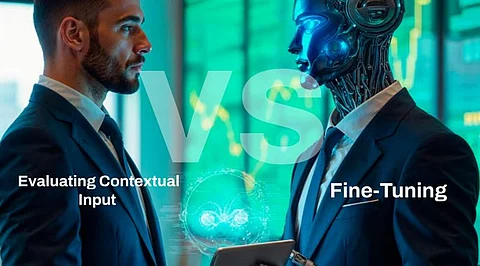

The optimization of LLMs depends primarily on two distinct strategies—contextual input and fine-tuning. Fine-tuning retrains LLMs on domain-specific datasets for specific tasks, allowing models to adapt and excel in particular applications. Retrieval-augmented generation (RAG) Pipeline chatbots are trained with contextual input. Contextual input provides LLMs with relevant information, such as prompts, examples, or external knowledge bases, and ensures more accurate and relevant outputs.
But how do you decide between contextual input and fine-tuning? To address this dilemma, here are some parameters to guide decision-making.
Contextual input needs relevant information within the prompt to guide the model's responses. With this method, LLMs generate accurate and tailored outputs without modifying their internal parameters. Take customer service interactions as an example. The model can produce personalized responses to increase user satisfaction only when user history is included in the prompt. Its effectiveness depends on the quality and relevance of that context.
Responding is easier using contextual data when model is not trained with domain-specific data in the RAG pipeline. It’s possible to add learnings from recent behaviour by adding the data in the corpus for custom data. However, this solution works well for shorter responses. For longer responses, the solution sometimes loses the context.
Fine-tuning involves training the model on domain-specific data to improve performance in specialized tasks. It adjusts the model's weights to help it understand and generate content aligned with the domain. For example, fine-tuning an LLM on medical literature increases its accuracy for diagnoses or treatment recommendations. The challenge requires substantial computational resources and access to high-quality, domain-specific datasets.
Availability of Sufficient, Unbiased Data: Obtaining a high-quality dataset free from biases is a challenge. Biased data can lead to skewed model outputs and affect the system's reliability and ethical integrity. This makes ensuring diversity and fairness in training data crucial.
Risk of Overfitting: Fine-tuning on a limited dataset increases the risk of overfitting. It makes the model too specialized and poor for unseen data. Overspecialization can compromise the model’s generalization capabilities and make it ineffective for broader applications. These issues can be mitigated using regularization techniques and diverse training datasets.
As the demand grows, model flexibility and adaptability become increasingly important. Users must decide based on three major factors and map them with their use cases-
Fine-tuning can enable precise output formatting in Small Language Models (2–13 B parameters), while embedding domain-specific knowledge across both small and large models. When trained on specialized datasets, fine-tuned models can produce highly structured outputs, such as JSON with enhanced accuracy and consistency, and can also internalize the vocabulary, style, and nuances of target domains.
Fine-tuning SLMs and LLMs models has its own advantages:
Consistent Structured Output: Fine-tuning enables smaller models to reliably produce structured formats like JSON (especially <13B parameter models), which can be inconsistent in non-fine-tuned models.
Domain-Specific Knowledge: Fine-tuning embeds critical domain knowledge directly into the model to improve accuracy without banking on external retrieval.
Fine-tuned models require less contextual input and simplify prompt engineering, as they inherently understand domain intricacies. However, RAG depends on comprehensive prompts to retrieve and generate relevant information. This increases the burden on prompt design.
RAG can incorporate current information by retrieving data from external and up-to-date sources. This makes it invaluable for rapidly evolving fields. Fine-tuned models remain static post-training and require periodic retraining to integrate new information. They don’t respond well to immediate data updates.
For example, when fine-tuning the Llama 3.1 8B model to extract key values from resumes - a smaller model initially struggled. However, fine-tuning enabled the model to learn expected patterns and perform effectively for the specific task. Earlier, it wasn’t just about getting the right JSON format 100% of the time—it is important to get the right values, which only happened around 70% of the time. It’s not that it returned wrong values, but some fields would just come back empty. The challenge is the need to retrain the model with every change. A better approach is periodic training combined with contextual input to stay updated.
Contextual input has the upper hand as it leverages existing models without the need for additional training. It is also more accessible and cost-effective for rapid deployment, as adjusting the input prompts requires minimal computational overhead. However, it poses challenges when the diversity of tasks increases, making managing and maintaining the quality of input prompts more complex.
Fine-tuning is time-consuming and eats up computational resources. Even a basic quantized version of the 7B parameter LLM model needs 2 GPUs. Training a 70B parameter model requires 15-20 A100 GPUs containing 80GB GPU memory. It only increases with the size of the datasets and models. Parameter adjustment in the model is resource-intensive and may not be an option for all organizations, in particular those that are limited in their access to a high-performance computing infrastructure. Though initially resource-consuming, fine-tuned models afford efficient inference performances tuned down to specific tasks.
By giving contextual input, the model needs to be carefully handled because it may be upset by so much irrelevant information. Too much context makes the responses incoherent or inaccurate, while not much context results in very generic outputs. The actual training also requires experts.
Fine-tuning imparts information within the model itself, meaning that it relies less on the external context during inference. By pairing fine-tuning with inference, the model ingests less complex inputs, which leads to better consistency. On the downside, fine-tuning needs high-quality data in the domain and must be properly guided by an expert.
Both contextual input and fine-tuning offer significant benefits for optimizing LLM performance. The most effective approach depends on the specific use case and available resources. For example, fine-tuning domain-specific language pairs in language translation can enhance accuracy but may require substantial computational resources. Fine-tuning can also help in building moats for companies eager to have competitive edge. Similarly, in content generation, incorporating topic-specific context improves relevance, but careful context management is required to avoid information overload.
